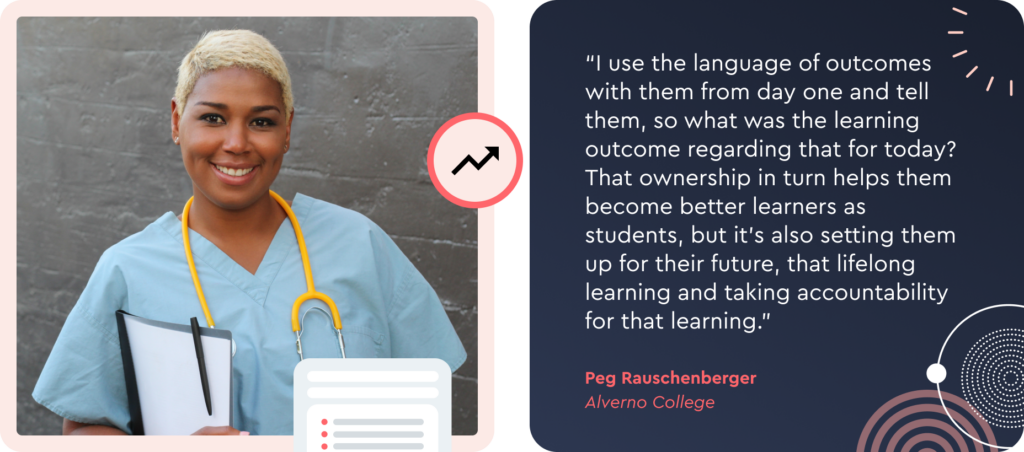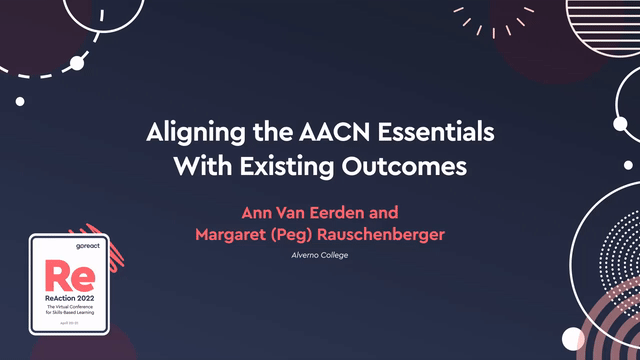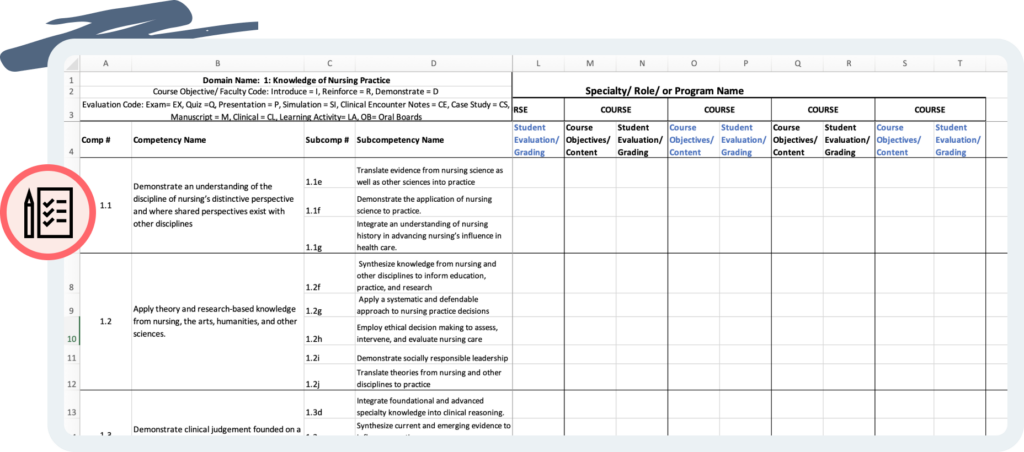This is the second of a three-part blog series on incorporating the new AACN Essentials into your curriculum.
Before we begin, fill out the form below to stay informed on other resources related to AACN Essentials and share ideas and best practices on implementing the new competency standards.
In this blog, we’re diving into Curriculum Mapping, the process for reviewing the Essentials represented in your courses, and where you can add learning and assessing activities to meet them. The strikethrough on Mapping is intentional—keep reading to understand why.
Since faculty engagement is key to successfully implementing change, these tips should prove to be useful no matter where you are in incorporating the new AACN Essentials.
Remember: You Aren’t Reinventing the Wheel
Groans usually erupt whenever curriculum mapping is mentioned. It seems like a huge undertaking that no one feels they have time for. But it’s important to understand and communicate to your team that curriculum mapping related to the new Essentials is not creating a new curriculum. You aren’t starting from scratch. You are making some adjustments to your existing curriculum by verifying outcomes and competencies are incorporated, integrating them if not, and ensuring proper assessment activities exist.
For the sake of clarification, while a lot of the activities outlined here mirror curriculum mapping processes, it may be easier to call the process curriculum evaluation and integration. Adjusting the terminology may make the process seem a bit less daunting.
“The domains, competencies, and concepts presented in the Essentials provide a platform for curriculum design and program assessment. But the intent is to produce some consistency and clarity, absolute clarity regarding the outcomes expected of graduates, so they are to be incorporated into each of our very unique curricula,” said Peg Rauschenberger, Dean Emerita of Nursing at Alverno College
It’s also important to note that the new Essentials are not a map for a new curriculum. Instead, the new domains, competencies, and subcompetencies should be woven into existing curriculum, and activities should be identified to promote and assess achievement of competencies.
“All of us have such wonderfully creative, unique, innovative curricula,” said Rauschenberger. “And so these Essentials are of course meant to be incorporated, but they aren’t the map for your curriculum.”
When you begin this process with your faculty, make sure they understand the new Essentials, they have a solid understanding of the reasons they were created, and that the end goal matches what all nurse educators already seek—to provide nurse graduates with best preparation for practice.
Review Outcomes
A great place to start for the curriculum review is with outcomes. If you already have established outcomes for your courses, review them and make sure they align with the Essentials. If outcomes are new for your program, going through the curriculum evaluation and integration process is an ideal opportunity to identify student or learning outcomes.

These outcomes should be specific, easily identifiable, and understandable. They should clearly tell students what specific skills they should be able to demonstrate and master. Students become more accountable when they clearly understand outcomes and expectations.
“I use the language of outcomes with them from day one and tell them, so what was the learning outcome regarding that for today? That ownership in turn helps them become better learners as students, but it’s also setting them up for their future, that lifelong learning and taking accountability for that learning,” said Peg Rauschenberger.

Outcomes should be tiered from institutional outcomes to program outcomes to course outcomes. A good practice is to review the 10 new domains and determine where there is alignment between the domains and the outcomes. Don’t panic if there isn’t—part of the process is to identify the gaps and create alignment.
Data Gathering
The next step is to develop a crosswalk and identify where the domains, competencies, and subcompetencies are already embedded within the curriculum.
The AACN has provided a few crosswalking templates, like this one.

Through crosswalking, the team can identify existing learning experiences and activities that already address the competencies and begin brainstorming new additions. This approach allows programs flexibility and innovation in designing their curriculum within the guidelines of the Essentials. Ultimately, the goal is to link curriculum, assessment, and instruction.
It is also within this process that you can determine if the outcome is introduced, reinforced, or assessed for mastery in each course. It’s also important to identify how the outcome is assessed—exam, sim presentation, etc. You will want to evaluate if these types of assessments are adequate as you are evolving the curriculum.
Traditional learning outcomes focus on memorization, demonstration, and passing tests. To support the new Essentials and shift to competency-based learning, focus on deep understanding, skill building, and then assessing.

Find the Gaps
Once competencies are mapped to courses, identify the gaps. Maybe a competency is introduced but never reinforced or assessed.
See what is missing in terms of outcomes and courses that align to competencies and subcompetencies. Then assess for these. Make sure there are multiple assessment points throughout the program.
When gaps are identified, you may need to modify existing courses or, in some cases, create new ones. It’s also important to look for redundancies or overlaps that may end up creating unnecessary work for faculty and slowing student progression.
Crosswalking also allows you to review assessment methods to ensure adequate assessing activities are built in to measure students’ mastery of the competencies. The next blog in this series will focus on effective assessment methods to support the new AACN Essentials.
Conclusion
Curriculum mapping is never truly done. Standards change, outcomes change, and courses will change. Fine-tuning the curriculum should be a continuous process. Remind your faculty that it doesn’t have to be a burden. In fact, it should set realistic and consistent learning expectations for students, ensure courses are effectively planned, and assess for competency mastery to ensure graduates are prepared for practice.
Hear more tips on curriculum mapping and competency-based education from nursing faculty at Alverno College, who have already incorporated the AACN Essentials into their program.
Read the next and final step in the AACN Essentials implementation, where we’ll cover assessment and feedback strategies for AACN success.










